Early-Age Mechanical Characteristics and Microstructure of Concrete Containing Mineral Admixtures under the Environment of Low Humidity and Large Temperature Variation
Abstract
:1. Introduction
2. Materials and Methods
2.1. Materials
2.2. Specimens Preparation
2.3. Curing Condition
2.4. Experimental Methods
2.4.1. Compression Test
2.4.2. Fracture Test
2.4.3. Scanning Electron Microscope (SEM) Observation
2.4.4. Air-Void System Determination
- Cutting the concrete specimens to make an observation surface, which must be perpendicular to the casting surface. The observation surface was smoothened and washed several times until it was flat with only pores and void left. Drying the specimens at a temperature of 105 ± 5 °C before detection.
- Observing the smooth surface by using the hardened concrete pore structure analyzer. The observation area was divided into multiple sub-areas with the same size and each sub-area was taken photos. These photos were binarized for determining the number of air-voids and the chord length by the linear traverse method.
- According to the collected information, the hardened concrete pore structure analyzer calculated the air-void system parameters of concrete, including the air content, average air-void size, and spacing factor. The air content can be considered as the porosity of concrete. The spacing factor represents the average distance between any point in the concrete matrix and the air-void, and a lower value of spacing factor means more air-voids in the observation area.
2.4.5. X-ray Diffraction Test
3. Results and Discussion
3.1. Mechanical Characteristics
3.1.1. Compression Strength
3.1.2. Load-CMOD Curves
3.1.3. Fracture Toughness
3.1.4. Fracture Energy
3.2. Microstructures of Concretes
3.2.1. SEM Images
3.2.2. Air-Void Characteristics
3.2.3. X-ray Diffraction Analysis
4. Conclusions
Author Contributions
Funding
Institutional Review Board Statement
Informed Consent Statement
Data Availability Statement
Conflicts of Interest
References
- National Bureau of Statistics of China. China Statistical Yearbook; China Statistics Press: Beijing, China, 2020. (In Chinese)
- Yang, Y.; Sato, R.; Kawai, K. Autogenous shrinkage of high-strength concrete containing silica fume under drying at early ages. Cem. Concr. Res. 2005, 35, 449–456. [Google Scholar] [CrossRef]
- Soliman, A.M.; Nehdi, M.L. Effect of drying conditions on autogenous shrinkage in ultra-high performance concrete at early-age. Mater. Struct. 2011, 44, 879–899. [Google Scholar] [CrossRef]
- Mi, Z.; Hu, Y.; Li, Q.; An, Z. Effect of curing humidity on the fracture properties of concrete. Constr. Build. Mater. 2018, 169, 403–413. [Google Scholar] [CrossRef]
- Wang, M.; Hu, Y.; Wang, Q.; Tian, H.; Liu, D. A study on strength characteristics of concrete under variable temperature curing conditions in ultra-high geothermal tunnels. Constr. Build. Mater. 2019, 229, 116989. [Google Scholar] [CrossRef]
- Husem, M.; Gozutok, S. The effects of low temperature curing on the compressive strength of ordinary and high performance concrete. Constr. Build. Mater. 2005, 19, 49–53. [Google Scholar] [CrossRef]
- Lothenbach, B.; Winnefeld, F.; Alder, C.; Wieland, E.; Lunk, P. Effect of temperature on the pore solution, microstructure and hydration products of Portland cement pastes. Cem. Concr. Res. 2007, 37, 483–491. [Google Scholar] [CrossRef]
- Zunino, F.; Castro, J.; Lopez, M. Thermo-mechanical assessment of concrete microcracking damage due to early-age temperature rise. Constr. Build. Materials 2015, 81, 140–153. [Google Scholar] [CrossRef]
- Babalola, O.E.; Awoyera, P.O.; Tran, M.T.; Le, D.H.; Olalusi, O.B.; Viloria, A. Mechanical and durability properties of recycled aggregate concrete with ternary binder system and optimized mix proportion. J. Mater. Res. Technol. 2020, 9, 6521–6532. [Google Scholar] [CrossRef]
- Guo, J.J.; Wang, K.; Qi, C.G. Determining the Mineral Admixture and Fiber on Mechanics and Fracture Properties of Concrete under Sulfate Attack. J. Mar. Sci. Eng. 2021, 9, 251. [Google Scholar] [CrossRef]
- Hosan, A.; Shaikh, F. Compressive strength development and durability properties of high volume slag and slag-fly ash blended concretes containing nano-CaCO3. J. Mater. Res. Technol. 2021, 10, 1310–1322. [Google Scholar] [CrossRef]
- Lee, J.H.; Yoon, Y.S. The effects of cementitious materials on the mechanical and durability performance of high-strength concrete. KSCE J. Civ. Eng. 2015, 19, 1396–1404. [Google Scholar] [CrossRef]
- Johari, M.; Brooks, J.; Kabir, S.; Rivard, P. Influence of supplementary cementitious materials on engineering properties of high strength concrete. Constr. Build. Mater. 2011, 25, 2639–2648. [Google Scholar] [CrossRef]
- Golewski, G.L. Effect of curing time on the fracture toughness of fly ash concrete composites. Compos. Struct. 2018, 185, 105–112. [Google Scholar] [CrossRef]
- Uysal, M.; Sumer, M. Performance of self-compacting concrete containing different mineral admixtures. Constr. Build. Mater. 2011, 25, 4112–4120. [Google Scholar] [CrossRef]
- Sun, J.C.; Wang, B.J.; Zhao, W.Z. Experimental Study on the Impact of Admixture for Concrete Heat of Hydration and Early-Age Contractile Properties. Appl. Mech. Mater. 2013, 253–255, 385–389. [Google Scholar] [CrossRef]
- Zhang, Y.; Sun, W.; Liu, S. Study on the hydration heat of binder paste in high-performance concrete. Cem. Concr. Res. 2002, 32, 1483–1488. [Google Scholar] [CrossRef]
- Shui, Z.H.; Rui, Z.; Chen, W. Effects of mineral admixtures on the thermal expansion properties of hardened cement paste. Constr. Build. Mater. 2010, 24, 1761–1767. [Google Scholar] [CrossRef]
- Jiang, C.; Yang, Y.; Wang, Y.; Zhou, Y.; Ma, C. Autogenous shrinkage of high performance concrete containing mineral admixtures under different curing temperatures. Constr. Build. Mater. 2014, 61, 260–269. [Google Scholar] [CrossRef]
- Wang, J.; Guo, Z.; Zhang, P.; Yuan, Q.; Guan, Q. Fracture properties of rubberized concrete under different temperature and humidity conditions based on digital image correlation technique. J. Clean. Prod. 2020, 276, 124106. [Google Scholar] [CrossRef]
- GB 175-2007. Common Portland Cement; Standards Press of China: Beijing, China, 2007. (In Chinese) [Google Scholar]
- GB/T 1956-2017. Fly Ash Used for Cement and Concrete; Standards Press of China: Beijing, China, 2017. (In Chinese) [Google Scholar]
- GB/T 18046-2008. Ground Granulated Blast Furnace Slag Used for Cement and Concrete; Standards Press of China: Beijing, China, 2008. (In Chinese) [Google Scholar]
- JGJ 55-2011. Specification for Mix Proportion Design of Ordinary Concrete; China Architecture & Building Press: Beijing, China, 2011. (In Chinese) [Google Scholar]
- Li, Y.; Jia, L.; Liang, X.L. A Experimental Study on the Influence of Fly Ash, Slag Powder on the Property of Concrete. Appl. Mech. Mater. 2013, 357–360, 582–587. [Google Scholar] [CrossRef]
- GB/T 50081-2019. Standard for Test Methods of Concrete Physical and Mechanical Properties; China Architecture & Building Press: Beijing, China, 2019. (In Chinese) [Google Scholar]
- Ince, R. Determination of the fracture parameters of the Double-K model using weight functions of split-tension specimens. Eng. Fract. Mech. 2012, 96, 416–432. [Google Scholar] [CrossRef]
- Guo, J.; Zhang, S.; Guo, T.; Zhang, P. Effects of UEA and MgO expansive agents on fracture properties of concrete. Constr. Build. Mater. 2020, 263, 120245. [Google Scholar] [CrossRef]
- Wee, T.H.; Babu, D.S.; Tamilselvan, T.; Lim, H.S. Air-void system of foamed concrete and its effect on mechanical properties. Aci Mater. J. 2006, 103, 45–52. [Google Scholar]
- SL 352-2020. Test Code for Hydraulic Concrete; China Water & Power Press: Beijing, China, 2020. (In Chinese) [Google Scholar]
- Özbay, E.; Erdemir, M.; Durmuş, H.İ. Utilization and efficiency of ground granulated blast furnace slag on concrete properties—A review. Constr. Build. Mater. 2016, 105, 423–434. [Google Scholar] [CrossRef]
- Al-Yousuf, A.; Pokharel, T.; Lee, J.; Gad, E.; Abdouka, K.; Sanjayan, J. Effect of fly ash and slag on properties of normal and high strength concrete including fracture energy by wedge splitting test: Experimental and numerical investigations. Constr. Build. Mater. 2021, 271, 121553. [Google Scholar] [CrossRef]
- Hanehara, S.; Tomosawa, F.; Kobayakawa, M.; Hwang, K. Effects of water/powder ratio, mixing ratio of fly ash, and curing temperature on pozzolanic reaction of fly ash in cement paste. Cem. Concr. Res. 2001, 31, 31–39. [Google Scholar] [CrossRef]
- Kim, J.K.; Moon, Y.H.; Eo, S.H. Compressive strength development of concrete with different curing time and temperature. Cem. Concr. Res. 1998, 28, 1761–1773. [Google Scholar] [CrossRef]
- Van Mier, J.G. Concrete Fracture: A Multiscale Approach; CRC Press: Boca Raton, FL, USA, 2012. [Google Scholar]
- Chindaprasirt, P.; Homwuttiwong, S.; Sirivivatnanon, V. Influence of fly ash fineness on strength, drying shrinkage and sulfate resistance of blended cement mortar. Cem. Concr. Res. 2004, 34, 1087–1092. [Google Scholar] [CrossRef]
- Tikkanen, J.; Cwirzen, A.; Penttala, V. Effects of mineral powders on hydration process and hydration products in normal strength concrete. Constr. Build. Mater. 2014, 72, 7–14. [Google Scholar] [CrossRef]
- Wang, K.; Guo, J.; Liu, X.; Yang, L.; Zhang, P. Effect of dry–wet ratio on pore-structure characteristics of fly ash concrete under sulfate attack. Mater. Struct. 2021, 54, 1–13. [Google Scholar] [CrossRef]

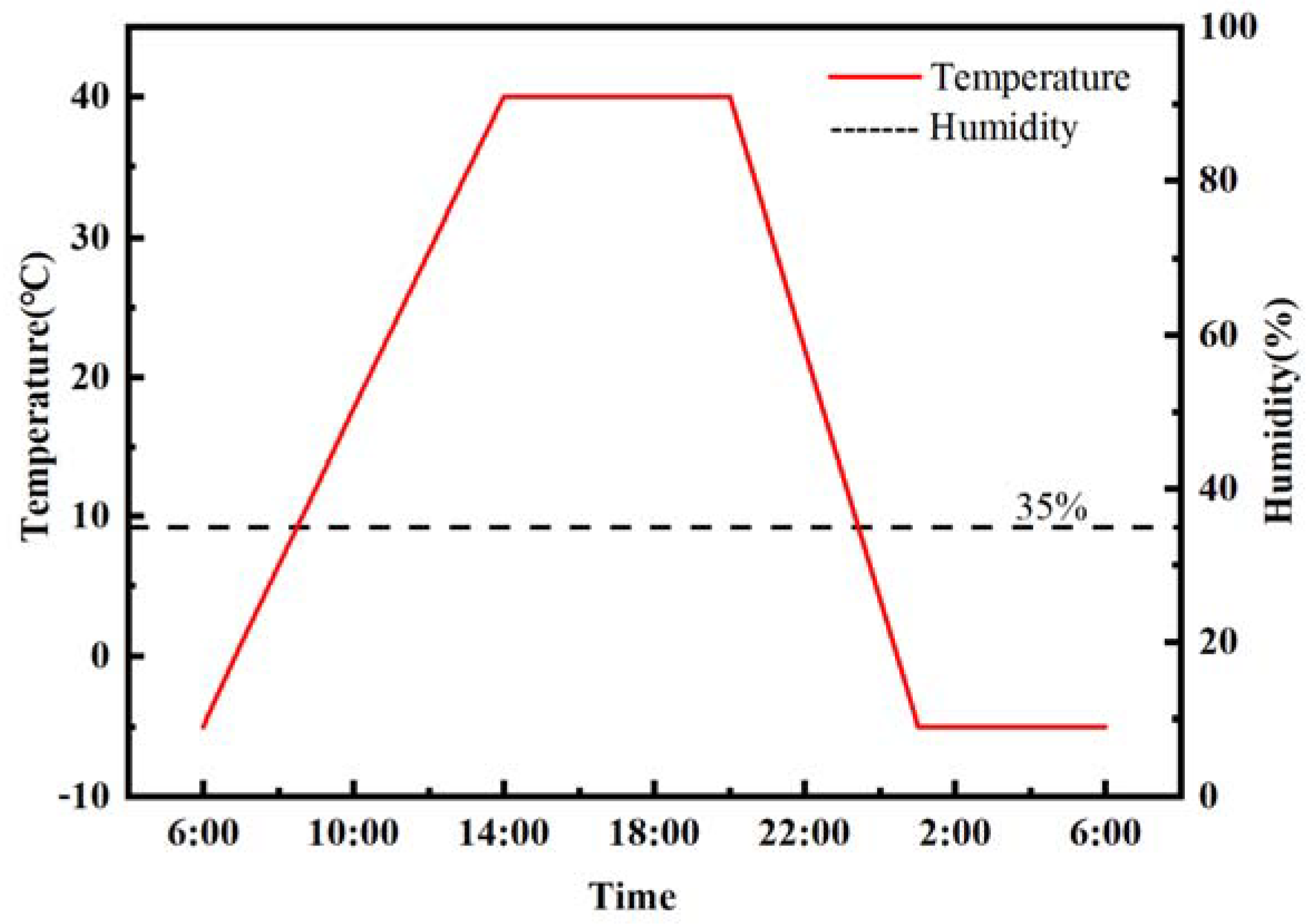
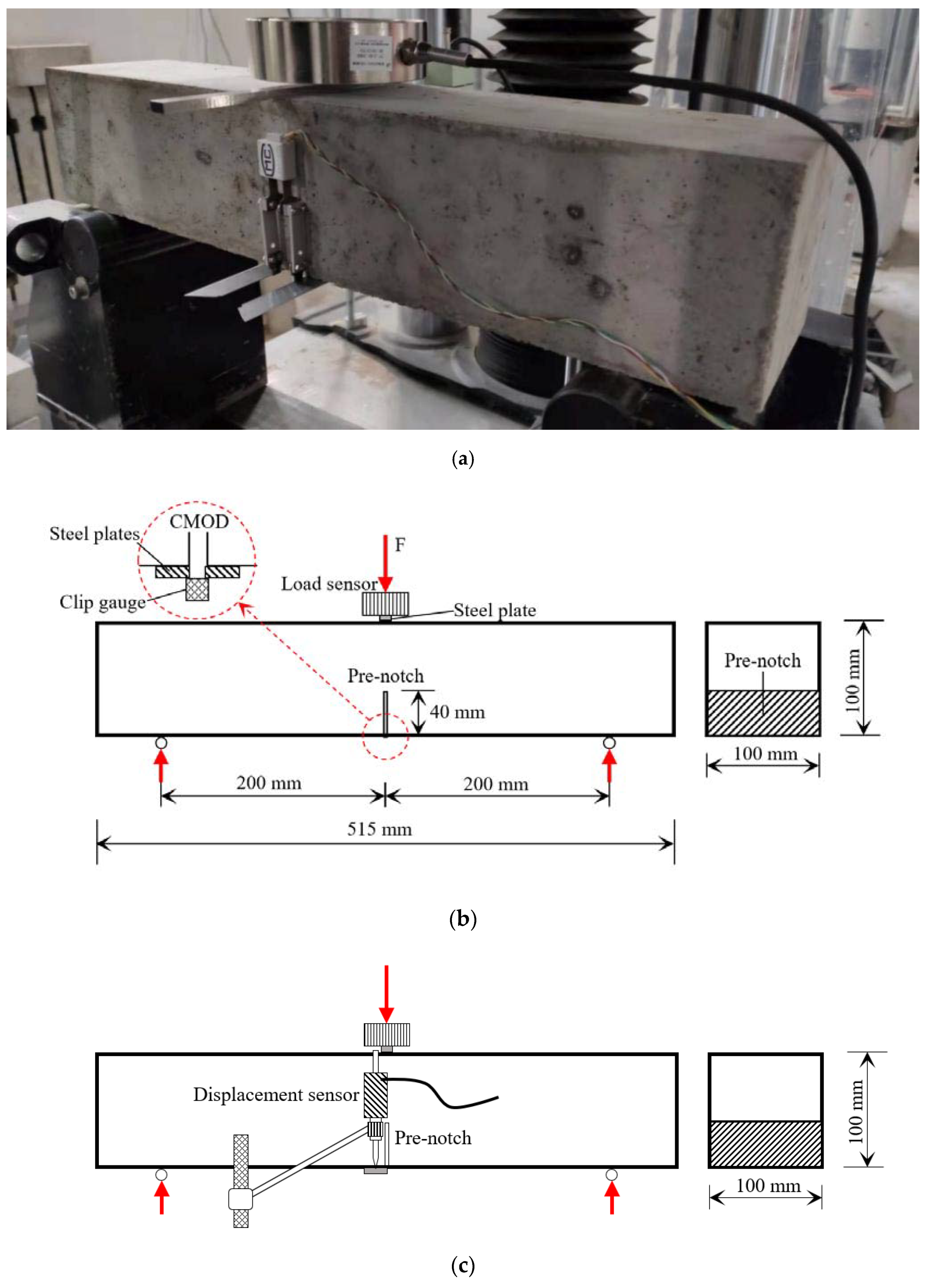
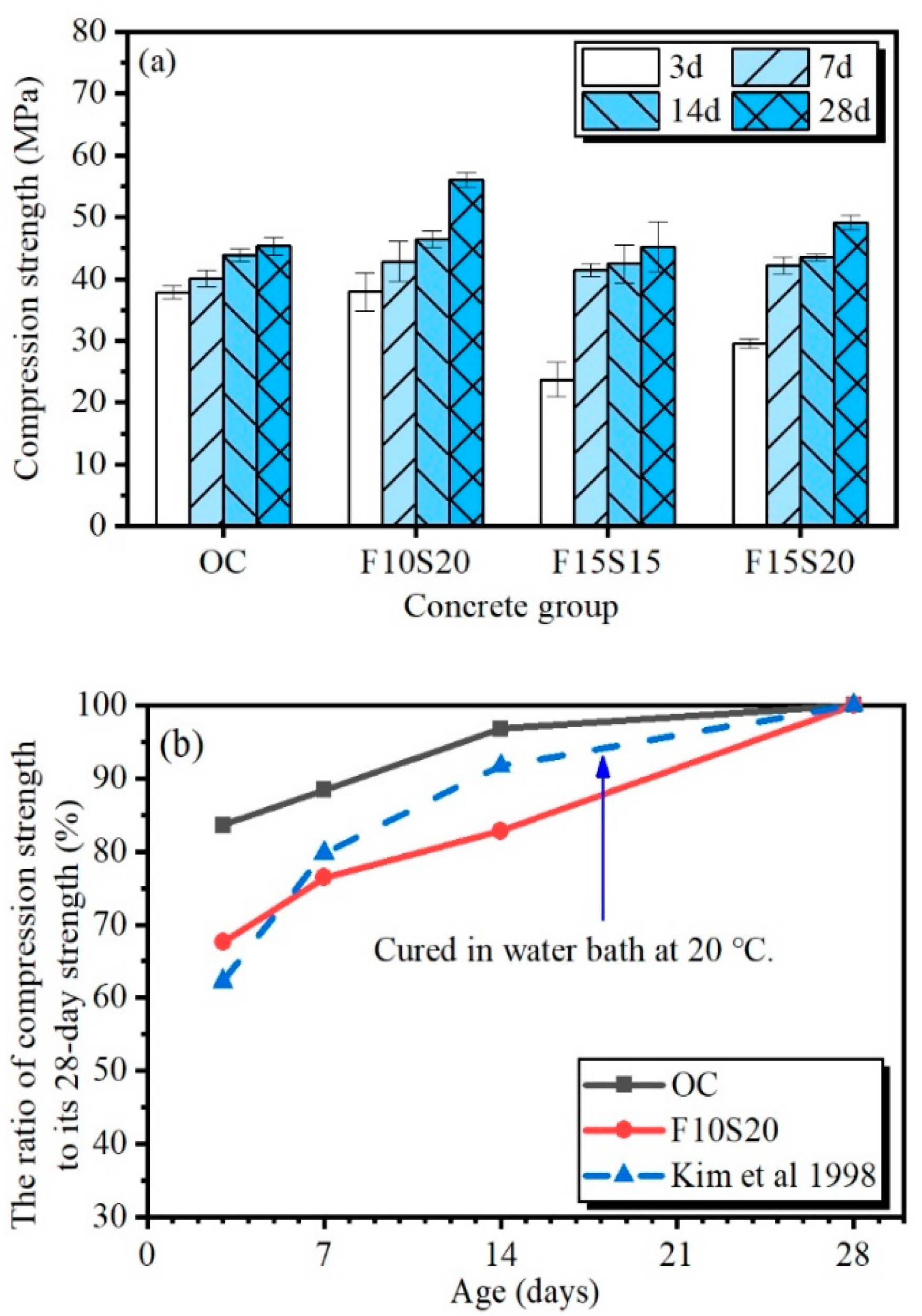
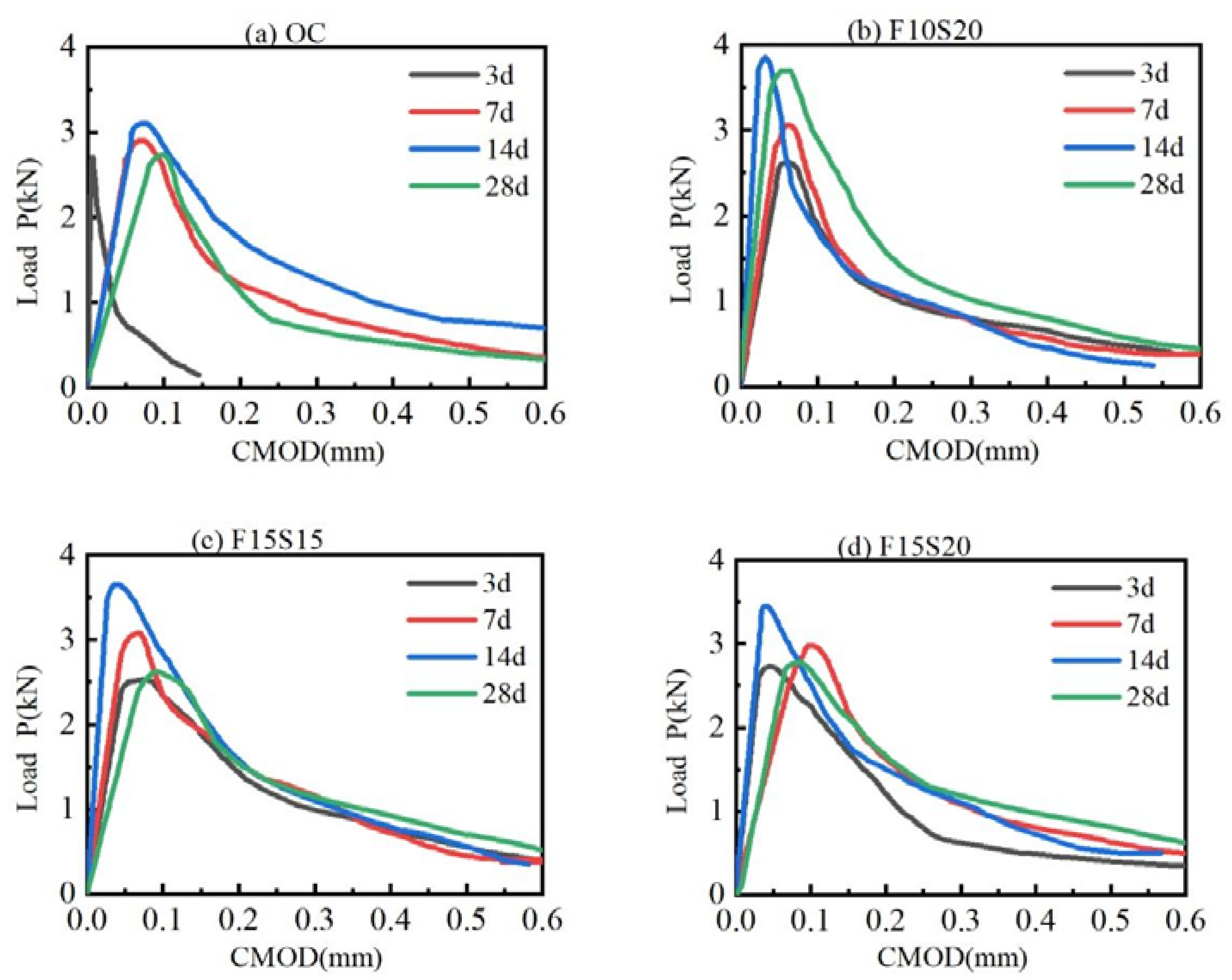
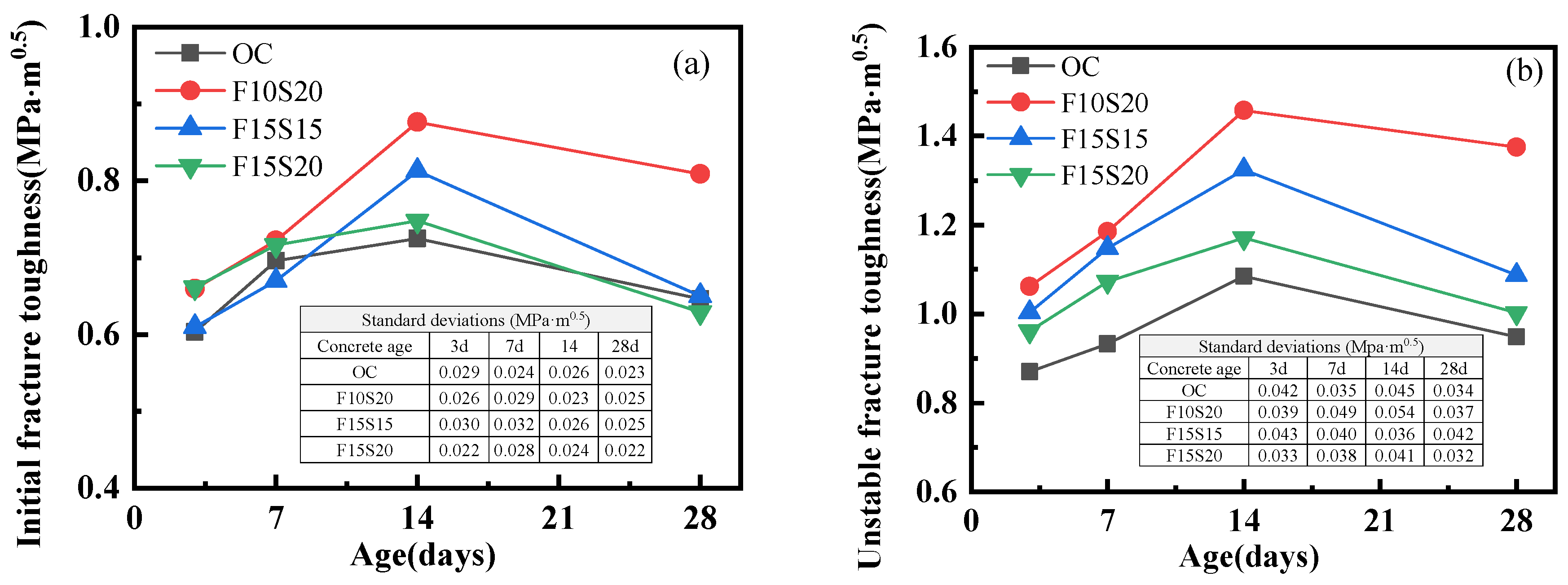
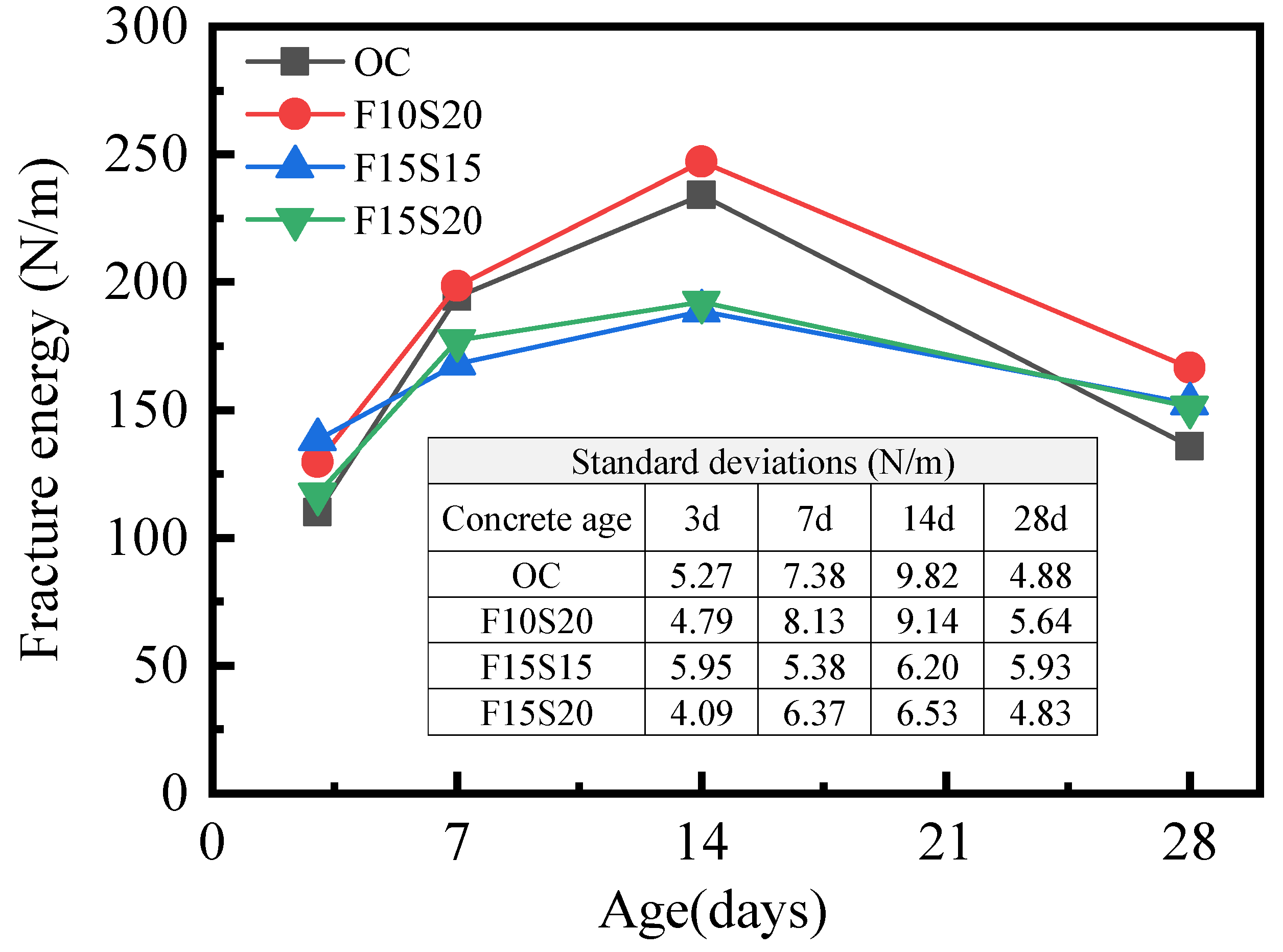

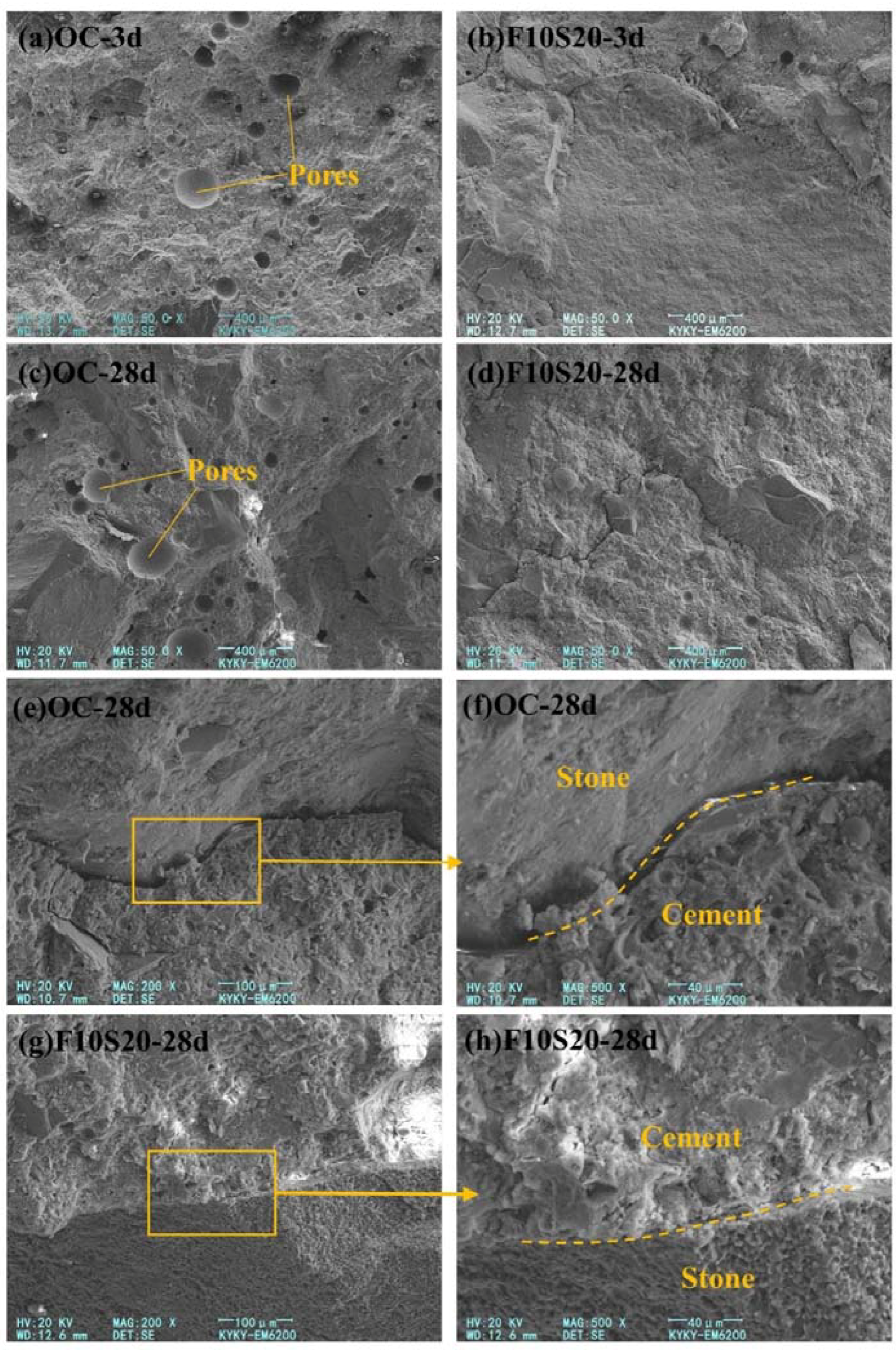

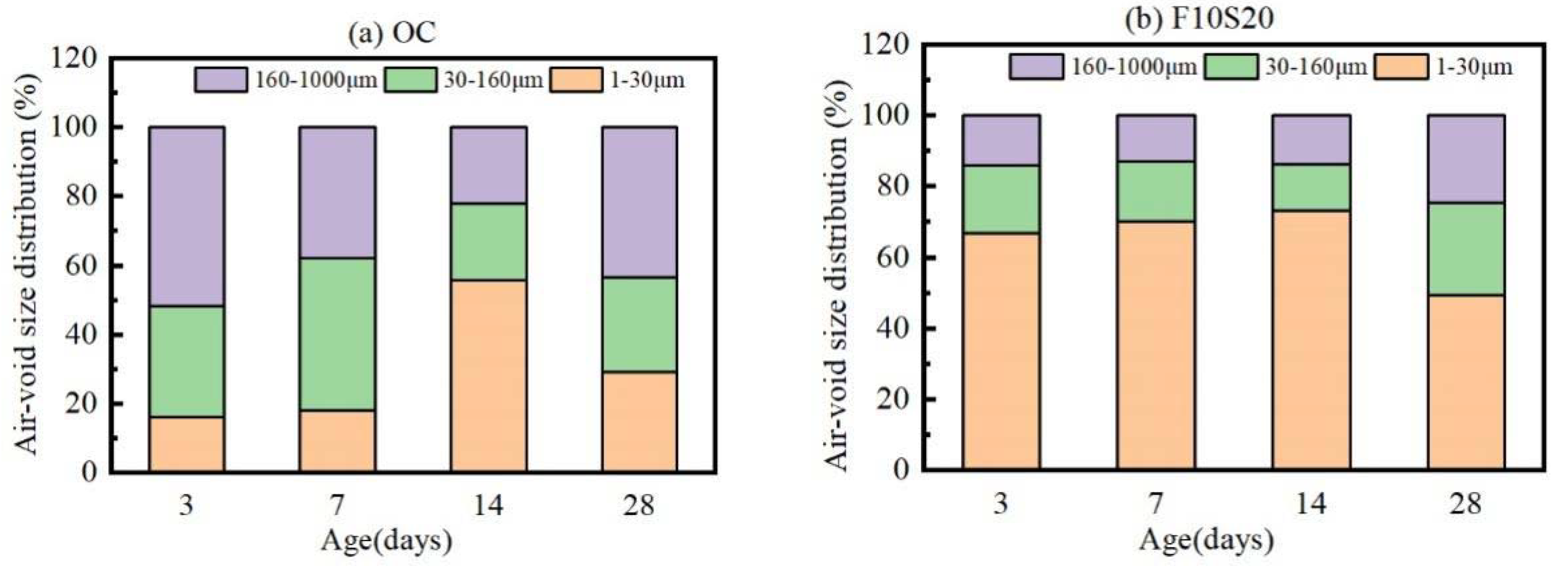

| Fly Ash | Fineness (%) | Water Demand Ratio (%) | Ignition Loss (%) | SO3 Content (%) | Density (g/cm3) | Water Content (%) |
| 10.8 | 91.5 | 4.6 | 2.2 | 2.3 | 0.5 | |
| Blast-Furnace Slag | Specific Surface Area (m2/kg) | Flow Ratio (%) | Activity Index 28d (%) | Density (g/cm3) | Ignition Loss (%) | Water Content (%) |
| 429 | 98.0 | 98.5 | 3.1 | 1.24 | 0.25 |
| Groups | Water | Cement | Fly Ash | Slag | Sand | Stone | Superplasticizer |
|---|---|---|---|---|---|---|---|
| OC | 160 | 400 | 0 | 0 | 699 | 1141 | 1.2 |
| F10S20 | 160 | 280 | 40 | 80 | 699 | 1141 | 1.2 |
| F15S15 | 160 | 280 | 60 | 60 | 699 | 1141 | 1.2 |
| F15S20 | 160 | 260 | 60 | 80 | 699 | 1141 | 1.2 |
Publisher’s Note: MDPI stays neutral with regard to jurisdictional claims in published maps and institutional affiliations. |
© 2021 by the authors. Licensee MDPI, Basel, Switzerland. This article is an open access article distributed under the terms and conditions of the Creative Commons Attribution (CC BY) license (https://creativecommons.org/licenses/by/4.0/).
Share and Cite
Guo, J.; Zhang, Z.; Wu, J.; Wang, H.; Zhang, P.; Wang, K.; Meng, Q.; Xu, H. Early-Age Mechanical Characteristics and Microstructure of Concrete Containing Mineral Admixtures under the Environment of Low Humidity and Large Temperature Variation. Materials 2021, 14, 5085. https://doi.org/10.3390/ma14175085
Guo J, Zhang Z, Wu J, Wang H, Zhang P, Wang K, Meng Q, Xu H. Early-Age Mechanical Characteristics and Microstructure of Concrete Containing Mineral Admixtures under the Environment of Low Humidity and Large Temperature Variation. Materials. 2021; 14(17):5085. https://doi.org/10.3390/ma14175085
Chicago/Turabian StyleGuo, Jinjun, Zheng Zhang, Jingjiang Wu, Huikang Wang, Peng Zhang, Kun Wang, Qingxin Meng, and Hongyin Xu. 2021. "Early-Age Mechanical Characteristics and Microstructure of Concrete Containing Mineral Admixtures under the Environment of Low Humidity and Large Temperature Variation" Materials 14, no. 17: 5085. https://doi.org/10.3390/ma14175085
APA StyleGuo, J., Zhang, Z., Wu, J., Wang, H., Zhang, P., Wang, K., Meng, Q., & Xu, H. (2021). Early-Age Mechanical Characteristics and Microstructure of Concrete Containing Mineral Admixtures under the Environment of Low Humidity and Large Temperature Variation. Materials, 14(17), 5085. https://doi.org/10.3390/ma14175085







